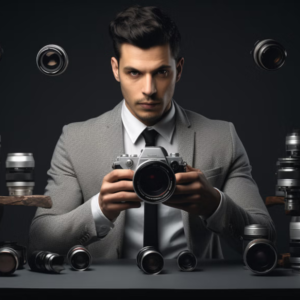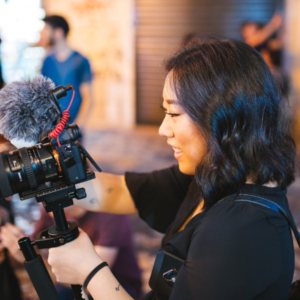Your Guide to Choosing the Perfect Camera
Choosing the right camera can be a daunting task, especially with the wide variety of options available on the market today. Whether you’re a beginner looking to capture your first shots, an enthusiast aiming to elevate your photography, or a professional seeking specific features, there’s a camera designed to suit your needs. This guide will help you navigate through the different types of cameras and key features to consider when making your choice.
Identify Your Needs and Purpose
1. Define Your Objective
-
Example: Are you purchasing a new sofa to increase comfort, enhance your living room’s aesthetic, or maximize storage? Your objective can be practical (functionality) or emotional (style, comfort).
-
Why It Works: Knowing your goal ensures you choose a product or service that aligns with your needs, preventing the selection of items that don’t fulfill the purpose.
2. Assess Your Priorities
-
Example: If you’re buying a car, you might prioritize fuel efficiency, safety, or luxury features. If it’s a work tool, perhaps speed, performance, and reliability top your list.
-
Why It Works: Identifying your top priorities allows you to make a focused decision, ensuring that the product serves your highest needs.
3. Consider Your Budget
-
Example: Set a realistic budget for your purchase. If you need an office desk, your budget will guide you toward affordable yet functional options.
-
Why It Works: Budgeting helps manage expectations and keeps you from overspending on features or luxuries that aren’t essential to fulfilling your needs.
4. Evaluate Long-Term Use
-
Example: Consider how long you will use the product. A durable, long-lasting laptop may be necessary for work, while a trendy accessory might not need the same level of durability.
-
Why It Works: Identifying whether the item will be used frequently or occasionally helps you prioritize durability or aesthetics depending on how it fits into your lifestyle.
5. Space and Fit
-
Example: When choosing furniture, assess whether the item will fit in your space and if it complements your existing décor.
-
Why It Works: Ensuring that what you choose fits into your environment avoids mismatches in functionality, size, and style. This also maximizes the utility of the item.
6. Functionality and Features
-
Example: For tech gadgets, think about whether you need all the latest features or if simpler functions will suffice.
-
Why It Works: Understanding what functions are essential allows you to choose products that focus on performance, not just looks, aligning your purchase with what you actually need.
7. Anticipate Future Needs
- Example: Will your family grow, or will your business needs expand? Choosing a product that can adapt or scale (like a modular desk or expandable wardrobe) could be more beneficial.
- Why It Works: This foresight prevents future disappointments and unnecessary re-purchasing by making sure your current choices can evolve with your changing needs.
8. Ethical and Environmental Impact
- Example: Do you want a sustainable or eco-friendly option, like biodegradable packaging or a product made with renewable materials?
- Why It Works: Considering ethical values and sustainability ensures your choices align with your personal or brand values, making your purchase feel more meaningful.
9. Emotional Connection
- Example: Some purchases, like a piece of art or a family heirloom, may have an emotional significance beyond practical use.
- Why It Works: Recognizing the emotional value of an item ensures that you make choices that resonate with your deeper desires, leading to greater satisfaction and long-term enjoyment.
10. Research and Information Gathering
- Example: Take time to read reviews, compare different options, or consult experts. A well-informed decision ensures you select the right product for your needs.
- Why It Works: Information helps clarify options, preventing poor decisions based on incomplete knowledge and leading you to a well-suited solution.
Before diving into the technical details, it’s important to consider what you want to achieve with your camera. Are you shooting for casual snapshots, travel photography, professional portraits, or action-packed sports shots? Understanding the purpose of your camera will help narrow down the choices.
- Casual Photography: If you want a camera for family events or everyday moments, a point-and-shoot camera or a mirrorless camera might be your best option. These are compact, user-friendly, and versatile.
- Travel Photography: A compact camera or a mirrorless camera with zoom lenses is ideal for portability and capturing a variety of scenes.
- Action or Sports Photography: If you’re into fast-paced photography, look for a camera with a high frame rate and fast autofocus, like a DSLR or a high-performance mirrorless camera.
- Professional Photography: For studio work or high-end commercial photography, a full-frame DSLR or mirrorless camera with a variety of interchangeable lenses would offer the highest image quality.

Understand Different Camera Types
DSLR (Digital Single-Lens Reflex) Cameras
- Key Features:
- Interchangeable lenses: DSLR cameras allow you to change lenses, offering greater flexibility for different types of photography (e.g., wide-angle, telephoto, macro).
- Optical viewfinder: DSLR cameras use a mirror mechanism that reflects light from the lens to the viewfinder, giving you a true optical view of the scene.
- Manual controls: Provides full control over settings like aperture, shutter speed, and ISO, which is ideal for experienced photographers.
- Large sensors: Many DSLRs feature full-frame or crop sensors that capture high-quality images with greater depth of field and low-light performance.
- Best For: Professional photographers, enthusiasts, and anyone who needs flexibility, image quality, and full manual control.
- Examples: Canon EOS 5D Mark IV, Nikon D850
2. Mirrorless Cameras
- Key Features:
- Interchangeable lenses: Like DSLRs, mirrorless cameras allow you to swap lenses for different styles of photography.
- Electronic viewfinder (EVF): Instead of an optical viewfinder, mirrorless cameras use an electronic display to show the image, which can help with exposure previews.
- Compact design: Mirrorless cameras are generally smaller and lighter than DSLRs because they don’t have the mirror and optical viewfinder system.
- Fast autofocus: Many mirrorless cameras offer faster autofocus and superior video capabilities compared to DSLRs.
- Best For: Enthusiasts, content creators, and travelers who want high-quality images and video without the bulk of a DSLR.
- Examples: Sony Alpha 7 III, Canon EOS R, Panasonic Lumix GH5
3. Point-and-Shoot Cameras
- Key Features:
- Fixed lens: Point-and-shoot cameras come with a non-interchangeable lens that covers a reasonable zoom range, offering convenience for casual photography.
- Compact size: These cameras are small, portable, and easy to carry around, making them great for everyday use.
- Automatic settings: Point-and-shoot cameras are designed to be user-friendly, with automatic modes for exposure, focus, and white balance.
- Lower image quality than DSLRs or mirrorless cameras: While they provide good results, their smaller sensors typically produce lower quality photos compared to more advanced camera types.
- Best For: Beginners, casual photographers, and anyone who needs a simple, portable camera for everyday use.
- Examples: Canon PowerShot G7 X Mark III, Sony Cyber-shot RX100 VII
4. Bridge Cameras
- Key Features:
- Superzoom lenses: Bridge cameras feature large, built-in zoom lenses, typically ranging from wide-angle to telephoto, making them versatile for various shooting situations.
- Semi-automatic controls: Bridge cameras allow for more manual control than point-and-shoot models but not as much as DSLRs or mirrorless cameras.
- Compact design: While larger than point-and-shoots, bridge cameras are still more portable than DSLRs and mirrorless cameras.
- Good all-in-one option: They provide a decent balance of performance, portability, and flexibility without needing to swap lenses.
- Best For: Travelers, wildlife photographers, and hobbyists who want an all-in-one solution without the hassle of changing lenses.
- Examples: Panasonic Lumix FZ1000, Nikon Coolpix P1000
5. Compact System Cameras (CSCs)
- Key Features:
- Small form factor: Like mirrorless cameras, compact system cameras are small and lightweight but typically have a fixed lens.
- Interchangeable lenses (in some models): Some CSCs come with interchangeable lenses, offering greater flexibility than traditional point-and-shoots.
- Manual controls: Many models allow for manual adjustments for exposure, focus, and other settings, making them suitable for those looking for more control than what a typical point-and-shoot offers.
- Large sensors: Some high-end CSCs feature larger sensors (e.g., Micro Four Thirds or APS-C sensors) for better image quality.
- Best For: Beginners who want a compact camera with more control than a point-and-shoot but without the bulk of a DSLR.
- Examples: Sony Alpha 6000, Olympus OM-D E-M10 Mark IV
6. Action Cameras
- Key Features:
- Small and rugged design: Action cameras are designed for use in extreme environments (e.g., underwater, high-impact activities).
- Wide-angle lens: They usually have a wide-angle lens that allows you to capture a broader view of action scenes.
- Waterproof and shockproof: Most action cameras are built to withstand water, dust, and drops, making them ideal for sports and adventure.
- Video-centric: Action cameras are often designed with video in mind, offering high-definition recording (4K in some models) and other video-centric features.
- Best For: Athletes, travelers, vloggers, and adventurers who need a compact camera for high-action shots and extreme conditions.
- Examples: GoPro HERO11, DJI Osmo Action
7. 360 Cameras
- Key Features:
- 360-degree video and photography: These cameras capture a complete 360-degree view, allowing you to create immersive, panoramic content.
- Multiple lenses: Typically, 360 cameras use two wide-angle lenses to capture all angles simultaneously.
- Compact and portable: These cameras are often small and lightweight, making them easy to carry for on-the-go shooting.
- High-definition video: Some models support 4K or even 8K video resolution for ultra-high-quality content.
- Best For: Vloggers, content creators, and anyone looking to create immersive or virtual reality content.
- Examples: Insta360 ONE X2, Ricoh Theta Z1
8. Film Cameras (Analog)
- Key Features:
- Uses traditional film rolls: Film cameras capture images on physical film rather than digitally.
- Manual controls: Many film cameras offer full manual control over settings, giving photographers a nostalgic, hands-on experience.
- Unique aesthetic: Film cameras often produce a distinct, grainy look that many photographers find appealing for certain artistic projects.
- Slower process: Since you need to develop film and wait for prints or scans, the process is more deliberate compared to digital photography.
- Best For: Photographers seeking a vintage, analog experience or those who enjoy the slower, more artistic side of photography.
- Examples: Canon AE-1, Nikon F100, Pentax K1000
9. Smartphone Cameras
- Key Features:
- Compact and convenient: Always with you, smartphones are one of the most accessible and portable camera options.
- High-tech features: Modern smartphones offer multiple lenses, large sensors, computational photography, and advanced AI features for improved photo quality.
- All-in-one solution: Smartphones can take photos, videos, and process images on the go with apps and cloud integration.
- Limitations: While improving rapidly, smartphone cameras are still limited in terms of sensor size, lens flexibility, and image quality compared to dedicated cameras.
- Best For: Casual photographers, social media users, and anyone who needs a camera at hand at all times.
- Examples: iPhone 15 Pro, Google Pixel 8 Pro, Samsung Galaxy S23 Ultra
- Point-and-Shoot Cameras:
These cameras are designed for simplicity. They are compact, lightweight, and come with automatic settings for easy operation. Point-and-shoots are great for casual users who want to point the camera and shoot without worrying about technical settings. - DSLR Cameras (Digital Single-Lens Reflex):
DSLRs are known for their exceptional image quality, wide range of lens options, and manual control over settings. They are favored by professionals and enthusiasts for their versatility and fast autofocus. They are larger and heavier than mirrorless cameras, but they excel in low-light conditions and offer optical viewfinders for precise framing. - Mirrorless Cameras:
Mirrorless cameras are more compact than DSLRs because they don’t have the internal mirror mechanism. Despite being smaller, many mirrorless cameras deliver image quality that rivals DSLRs. They offer quick autofocus and a more silent shooting experience, making them popular among both photographers and videographers. Mirrorless cameras also typically offer a higher frame rate for shooting fast action. - Compact and Bridge Cameras:
These are ideal for those who need something in between point-and-shoot and DSLR cameras. They are a bit larger than typical point-and-shoots, with better zoom and manual controls, but still relatively portable. Bridge cameras offer a fixed zoom lens, often with impressive zoom capabilities. - Action Cameras:
If you’re into extreme sports, adventure, or underwater photography, an action camera like a GoPro is perfect. These cameras are small, rugged, and built to withstand tough environments, often with waterproof features and 4K recording. 
3. Key Features to Consider
- Megapixels:
While megapixels are important for image resolution, they’re not the sole indicator of image quality. A higher megapixel count helps if you plan on cropping your images or printing large photos. However, sensor size and lens quality play a much bigger role in the overall image quality. - Sensor Size:
A larger sensor captures more light, which improves low-light performance and provides better dynamic range. Full-frame sensors are the largest and most expensive but provide the best image quality. APS-C sensors are common in mid-range cameras, offering great performance at a more affordable price. - Autofocus System:
Fast and accurate autofocus is crucial, especially for capturing fast-moving subjects like children or sports. Look for cameras with phase-detection autofocus or hybrid autofocus systems (which combine phase and contrast detection) for better performance. - Video Capabilities:
If you plan to shoot video as well, look for cameras that offer 4K video recording, slow-motion features, and advanced audio controls. Mirrorless cameras and some DSLRs provide excellent video quality, and many now offer features specifically designed for vloggers or content creators. - Battery Life:
For extended shooting sessions, especially when traveling, camera battery life is important. DSLRs and mirrorless cameras with larger bodies tend to offer longer battery life, while smaller point-and-shoot or mirrorless cameras may need extra batteries for long days. - Image Stabilization:
If you plan on shooting handheld or in low-light environments, image stabilization can reduce camera shake and produce clearer photos. Many newer cameras have built-in stabilization, but some lenses also offer this feature.
4. Budget Considerations
Cameras range in price from a few hundred dollars to several thousand, depending on the features and brand. It’s important to set a budget that aligns with your needs. While you may want a high-end camera, also remember that lenses, memory cards, camera bags, and other accessories can add to the cost.
5. Try Before You Buy
Whenever possible, visit a camera store to hold and test different models. Comfort, ease of use, and ergonomics are just as important as specifications, especially if you plan on using the camera for extended periods.
Conclusion
Choosing the perfect camera boils down to your unique needs, preferences, and budget. Whether you’re an aspiring photographer or a seasoned pro, there’s a camera out there for you. Take the time to research and compare different models, and you’ll find the one that fits perfectly into your creative vision. Happy shooting!
Suggested Keywords: choose the perfect camera, best cameras for beginners, DSLR vs mirrorless, camera buying guide, camera features, photography


